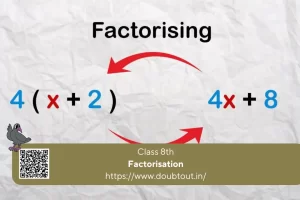
NCERT Solutions for Class 8 Maths Chapter 6 Cubes and Cube Roots (Updated Pattern)

Chapter 6 of Class 8 Maths helps the students find the cubes and cube roots of different numbers, understand the difference between cubes and cube roots, and also have fun with some interesting patterns. The chapter also lets the students understand the process of finding out the cubes and cube roots of a number using the prime factorisation method. Moreover, the chapter also explains the method of finding the cube root of a cube number. Learning the chapter “Cubes and Cube Roots” enables the students to:
- Find out the Cubes and cubes roots for numbers containing at most 3 digits
- Estimating cube roots and cube roots.
- Learning the process of moving nearer to the required number.
1. Which of the following numbers are not perfect cubes?
(i) 216
Solution:
By resolving 216 into a prime factor,

216 = 2×2×2×3×3×3
By grouping the factors in triplets of equal factors, 216 = (2×2×2)×(3×3×3)
Here, 216 can be grouped into triplets of equal factors,
∴ 216 = (2×3) = 6
Hence, 216 is the cube of 6.
(ii) 128
Solution:
By resolving 128 into a prime factor,

128 = 2×2×2×2×2×2×2
By grouping the factors in triplets of equal factors, 128 = (2×2×2)×(2×2×2)×2
Here, 128 cannot be grouped into triplets of equal factors, and we are left with one factor: 2.
∴ 128 is not a perfect cube.
NCERT Class 8 Maths Chapter 5 – Squares and Square Roots (Updated Pattern)
(iii) 1000
Solution:
By resolving 1000 into prime factor,

1000 = 2×2×2×5×5×5
By grouping the factors in triplets of equal factors, 1000 = (2×2×2)×(5×5×5)
Here, 1000 can be grouped into triplets of equal factors.
∴ 1000 = (2×5) = 10
Hence, 1000 is the cube of 10.
(iv) 100
Solution:
By resolving 100 into a prime factor,

100 = 2×2×5×5
Here, 100 cannot be grouped into triplets of equal factors.
∴ 100 is not a perfect cube.
(v) 46656
Solution:
By resolving 46656 into prime factor,

46656 = 2×2×2×2×2×2×3×3×3×3×3×3
By grouping the factors in triplets of equal factors, 46656 = (2×2×2)×(2×2×2)×(3×3×3)×(3×3×3)
Here, 46656 can be grouped into triplets of equal factors,
∴ 46656 = (2×2×3×3) = 36
Hence, 46656 is the cube of 36.
2. Find the smallest number by which each of the following numbers must be multiplied to obtain a perfect cube.
(i) 243
Solution:
By resolving 243 into a prime factor,

243 = 3×3×3×3×3
By grouping the factors in triplets of equal factors, 243 = (3×3×3)×3×3
Here, 3 cannot be grouped into triplets of equal factors.
∴ We will multiply 243 by 3 to get the perfect cube.
(ii) 256
Solution:
By resolving 256 into a prime factor,

256 = 2×2×2×2×2×2×2×2
By grouping the factors in triplets of equal factors, 256 = (2×2×2)×(2×2×2)×2×2
Here, 2 cannot be grouped into triplets of equal factors.
∴ We will multiply 256 by 2 to get the perfect cube.
(iii) 72
Solution:
By resolving 72 into a prime factor,

72 = 2×2×2×3×3
By grouping the factors in triplets of equal factors, 72 = (2×2×2)×3×3
Here, 3 cannot be grouped into triplets of equal factors.
∴ We will multiply 72 by 3 to get the perfect cube.
(iv) 675
Solution:
By resolving 675 into a prime factor,

675 = 3×3×3×5×5
By grouping the factors in triplets of equal factors, 675 = (3×3×3)×5×5
Here, 5 cannot be grouped into triplets of equal factors.
∴ We will multiply 675 by 5 to get the perfect cube.
(v) 100
Solution:
By resolving 100 into a prime factor,

100 = 2×2×5×5
Here, 2 and 5 cannot be grouped into triplets of equal factors.
∴ We will multiply 100 by (2×5) 10 to get the perfect cube.
3. Find the smallest number by which each of the following numbers must be divided to obtain a perfect cube.
The Secret of Padmasana: Unlocking Meditation and Inner Balance with the Lotus Pose
(i) 81
Solution:
By resolving 81 into a prime factor,

81 = 3×3×3×3
By grouping the factors in triplets of equal factors, 81 = (3×3×3)×3
Here, 3 cannot be grouped into triplets of equal factors.
∴ We will divide 81 by 3 to get the perfect cube.
(ii) 128
Solution:
By resolving 128 into a prime factor,

128 = 2×2×2×2×2×2×2
By grouping the factors in triplets of equal factors, 128 = (2×2×2)×(2×2×2)×2
Here, 2 cannot be grouped into triplets of equal factors.
∴ We will divide 128 by 2 to get the perfect cube.
(iii) 135
Solution:
By resolving 135 into prime factor,

135 = 3×3×3×5
By grouping the factors in triplets of equal factors, 135 = (3×3×3)×5
Here, 5 cannot be grouped into triplets of equal factors.
∴ We will divide 135 by 5 to get the perfect cube.
(iv) 192
Solution:
By resolving 192 into a prime factor,

192 = 2×2×2×2×2×2×3
By grouping the factors in triplets of equal factors, 192 = (2×2×2)×(2×2×2)×3
Here, 3 cannot be grouped into triplets of equal factors.
∴ We will divide 192 by 3 to get the perfect cube.
(v) 704
Solution:
By resolving 704 into a prime factor,

704 = 2×2×2×2×2×2×11
By grouping the factors in triplets of equal factors, 704 = (2×2×2)×(2×2×2)×11
Here, 11 cannot be grouped into triplets of equal factors.
∴ We will divide 704 by 11 to get the perfect cube.
4. Parikshit makes a cuboid of plasticine with sides 5 cm, 2 cm, and 5 cm. How many such cuboids will he need to form a cube?
Solution:
Given the sides of the cube are 5 cm, 2 cm and 5 cm.
∴ Volume of cube = 5×2×5 = 50

50 = 2×5×5
Here, 2, 5 and 5 cannot be grouped into triplets of equal factors.
∴ We will multiply 50 by (2×2×5) 20 to get the perfect cube. Hence, 20 cuboids are needed.
Cubes and Cube Roots
—————–Exercise 6.2——————–
1. Find the cube root of each of the following numbers by the prime factorisation method.
(i) 64
Solution:
64 = 2×2×2×2×2×2
By grouping the factors in triplets of equal factors, 64 = (2×2×2)×(2×2×2)
Here, 64 can be grouped into triplets of equal factors.
∴ 64 = 2×2 = 4
Hence, 4 is the cube root of 64.
(ii) 512
Solution:
512 = 2×2×2×2×2×2×2×2×2
By grouping the factors in triplets of equal factors, 512 = (2×2×2)×(2×2×2)×(2×2×2)
Here, 512 can be grouped into triplets of equal factors.
∴ 512 = 2×2×2 = 8
Hence, 8 is the cube root of 512.
(iii) 10648
Solution:
10648 = 2×2×2×11×11×11
By grouping the factors in triplets of equal factors, 10648 = (2×2×2)×(11×11×11)
Here, 10648 can be grouped into triplets of equal factors.
∴ 10648 = 2 ×11 = 22
Hence, 22 is the cube root of 10648.
(iv) 27000
Solution:
27000 = 2×2×2×3×3×3×3×5×5×5
By grouping the factors in triplets of equal factors, 27000 = (2×2×2)×(3×3×3)×(5×5×5)
Here, 27000 can be grouped into triplets of equal factors.
∴ 27000 = (2×3×5) = 30
Hence, 30 is the cube root of 27000.
(v) 15625
Solution:
15625 = 5×5×5×5×5×5
By grouping the factors in triplets of equal factors, 15625 = (5×5×5)×(5×5×5)
Here, 15625 can be grouped into triplets of equal factors.
∴ 15625 = (5×5) = 25
Hence, 25 is the cube root of 15625.
(vi) 13824
Solution:
13824 = 2×2×2×2×2×2×2×2×2×3×3×3
By grouping the factors in triplets of equal factors,
13824 = (2×2×2)×(2×2×2)×(2×2×2)×(3×3×3)
Here, 13824 can be grouped into triplets of equal factors.
∴ 13824 = (2×2× 2×3) = 24
Hence, 24 is the cube root of 13824.
(vii) 110592
Solution:
110592 = 2×2×2×2×2×2×2×2×2×2×2×2×3×3×3
By grouping the factors in triplets of equal factors,
110592 = (2×2×2)×(2×2×2)×(2×2×2)×(2×2×2)×(3×3×3)
Here, 110592 can be grouped into triplets of equal factors.
∴ 110592 = (2×2×2×2 × 3) = 48
Hence, 48 is the cube root of 110592.
(viii) 46656
Solution:
46656 = 2×2×2×2×2×2×3×3×3×3×3×3
By grouping the factors in triplets of equal factors,
46656 = (2×2×2)×(2×2×2)×(3×3×3)×(3×3×3)
Here, 46656 can be grouped into triplets of equal factors.
∴ 46656 = (2×2×3×3) = 36
Hence, 36 is the cube root of 46656.
(ix) 175616
Solution:
175616 = 2×2×2×2×2×2×2×2×2×7×7×7
By grouping the factors in triplets of equal factors,
175616 = (2×2×2)×(2×2×2)×(2×2×2)×(7×7×7)
Here, 175616 can be grouped into triplets of equal factors.
∴ 175616 = (2×2×2×7) = 56
Hence, 56 is the cube root of 175616.
(x) 91125
Solution:
91125 = 3×3×3×3×3×3×3×5×5×5
By grouping the factors in triplets of equal factors, 91125 = (3×3×3)×(3×3×3)×(5×5×5)
Here, 91125 can be grouped into triplets of equal factors.
∴ 91125 = (3×3×5) = 45
Hence, 45 is the cube root of 91125.
2. State true or false.
(i) The cube of any odd number is even.
Solution:
False
(ii) A perfect cube does not end with two zeros.
Solution:
True
(iii) If the cube of a number ends with 5, then its cube ends with 25.
Solution:
False
(iv) There is no perfect cube which ends with 8.
Solution:
False
(v) The cube of a two-digit number may be a three-digit number.
Solution:
False
(vi) The cube of a two-digit number may have seven or more digits.
Solution:
False
(vii) The cube of a single-digit number may be a single-digit number.
Solution:
True






